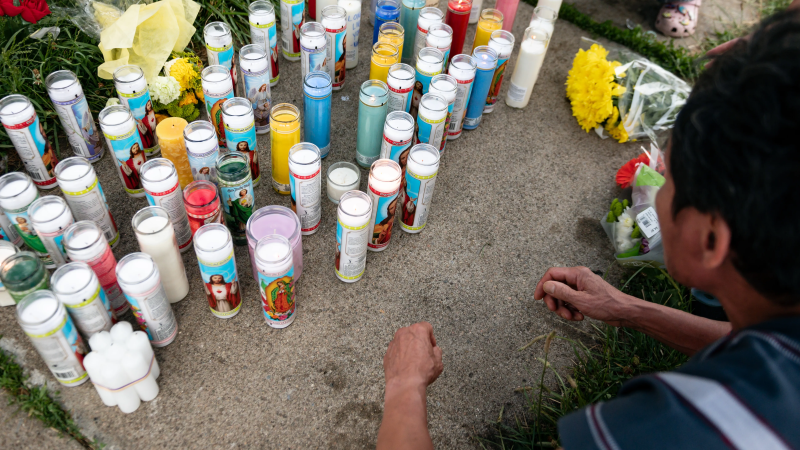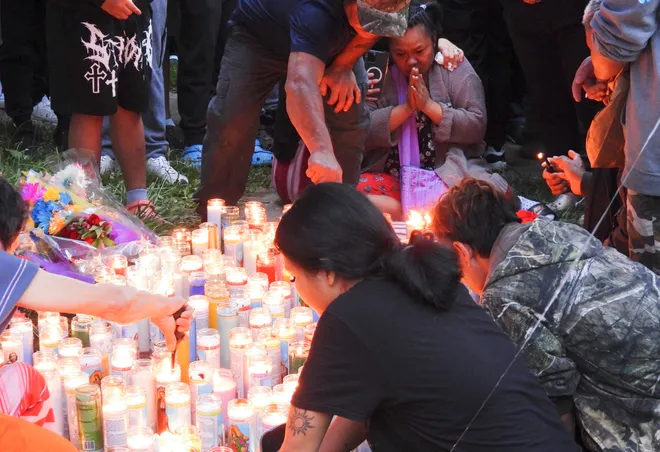'It was me': New York police release footage in fatal shooting of 13-year-old Nyah Mway

UTICA, N.Y. — Authorities in New York released body camera footage on Sunday showing a police officer fatally shooting a 13-year-old boy after he allegedly aimed an object that was later determined to be a pellet gun during a foot chase on Friday night.
The incident unfolded at around 10:18 p.m. on Friday when Utica police officers were conducting a pedestrian stop of two people in a residential area. During the stop, the 13-year-old boy — who was identified as Nyah Mway — fled from police and displayed what appeared to be a handgun during the chase, according to Utica Police Chief Mark Williams.
An officer then fired one shot and wounded the teen, Williams said. Nyah was taken to Wynn Hospital, where he died from his injuries.
Police said they recovered a replica GLOCK 17 handgun, which was determined to be a pellet gun.
The body camera footage was published on the police department's YouTube channel in six separate videos of varying lengths. Police also released photos of the pellet gun Nyah allegedly had when he was fatally shot.
"As always, we are committed to transparency and earning the public’s trust in our investigations," the Utica Police Department said in a Saturday statement on the officer-involved shooting. "As much information as allowable will be released during this process."
The fatal shooting has caused an outpouring of outrage and demands for justice in Utica's Karen immigrant community, an ethnic minority from Southeast Asia. Hundreds of people attended a candlelight vigil in memory of Nyah on Saturday night.
'Wrongful conviction capital':$50M wrongful conviction case highlights decades of Chicago police forced confessions
'It was one shot'
The three Utica police officers involved in the incident were identified as Patrick Husnay, a six-year veteran with the department who fired at the teen; Bryce Patterson, a four-year veteran; and Andrew Citriniti, who has been on the police force for two-and-a-half years.
The body camera footage showed the three officers approach Nyah and another juvenile, who was on a bicycle. Patterson is shown in the footage telling the teens they are being stopped because one teen was riding the bike in the road, while Nyah was walking nearby.
Nyah — who initially had his hands up in the air — was then seen running away after officers asked if they could pat him down to see if he had any weapons, according to the footage. Patterson and Husnay ran after Nyah, with Patterson taking the teen down after a short chase as officers can be heard screaming "He’s got a gun."
Husnay had his gun drawn and appeared to shoot Nyah when he was down on the ground, his released body camera footage showed.
"It was one shot," Husnay can be heard saying, according to the released footage. "It was me."
All three officers involved in the incident were placed on paid administrative leave, pending an investigation.
New York State Attorney General's Office launches probe
On Saturday, the New York Attorney General’s Office of Special Investigation announced it had opened an investigation into the death of Nyah.
New York State Executive Law 70-b mandates that the New York State Attorney General's Office of Special Investigations has the lead criminal investigatory role in officer-involved shootings.
"If OSI’s assessment indicates an officer may have caused the death, OSI proceeds to conduct a full investigation of the incident," the state attorney general's office said in a statement. "These are preliminary facts and subject to change."
The Utica Police Department is conducting a joint parallel internal investigation with its Professional Standards Unit to determine if policies, procedures, and training were followed. Additionally, Utica police said it will work closely and openly with the City of Utica Public Safety Advisory Committee.
'The stories don't add up'
Around 24 hours after Nyah was shot and killed by police, members of the community gathered for a candlelight vigil and mourned the teen's death. The heat from a hundred candles was carried on the breeze through a crowd of three times as many.
"We gather here to honor and support our little brother, Nyah Mway," said speaker Kay Klo, director at Midtown Utica Community Center. "He was tragically murdered by police officers."
Though officials have declared that an investigation is underway, members of the Karen community feel betrayed. Klo said nine years ago, the Mway family came to America seeking safety from "military, wars, and police violence."
With wounds of persecution at the hands of the military and police in their home country still fresh in many of their minds, the Karen community of Utica is demanding justice.
"The stories don’t add up," Klo said. "The story they told at the press conference, what witnesses say they say, and what was seen in the video. None of it adds up. The police officers need to be investigated and held accountable for their actions."
Klo’s words echoed through the streets before the same message in the Karenic language was repeated, mingling together to make a single cry for justice. Buddhist monks from the community, many who settled in Utica as refugees from Cambodia, spoke to the crowd in their native tongue and carried them through a Buddhist prayer for Nyah.
At the end of the prayer, the monk spoke in English, asking the crowd, "What do we need?"
It was quickly echoed back with the word "justice," again they were asked, and again they said "justice."
Pastor Debbie Kelsey of Tabernacle Baptist Church spoke to those in attendance.
"Some of us come as (Nyah Mway’s) family. Some come as friends. Some are classmates and some are neighbors," she said. "All of us are part of this community and all of us are here to say that Nyah Mway lived. And he was loved. And he will never be forgotten."

Who are the Karen people?
Utica, a Rust Belt city in New York's Mohawk Valley about 55 miles east of Syracuse, New York, is home to a rapidly growing, refugee population that includes thousands of Karen people.
Pronounced "ka-ren" and also known as the Kayin, Kariang, or Kawthoolese, the Karen people are a large and dispersed ethnic group of Southeast Asia, with origins traced to the Gobi Desert, Mongolia, or Tibet — according to the Karen Women’s Organization. The Karen then settled in Myanmar, formerly known as Burma.
Under British colonization in the mid-to-late 19th century, administrators recruited many Karen people into their police and armed forces, according to the organization. During World War II and the Burma Campaign, the Karen people became loyal guerrilla fighters for the Allies against Japanese occupiers.
When Britain granted Burma independence after the war, the Karen people had hoped to form their own nation. Instead, they were absorbed into the new Union of Burma, later renamed Union of Myanmar in 1989.
Troops of the predominantly Burmese government killed Karen villagers, and Karen insurgency sprang up, resulting in a conflict lasting until 1962 when the government pledged to quell and unify the country. The so-called "Four Cuts" offensive intended to separate rebels from their food sources, funds, intelligence, and recruits. It lasted until 1990.
A ceasefire was reached in 2012. But well before that, refugees were resettled in refugee camps, many of which were across the border in Thailand, according to the Karen Organization of Minnesota. Refugees in Thailand were not allowed to venture outside the crowded camps they occupied and were arrested by Thai police if caught.
And some refugees resettled in numerous countries — including the United States.
Contributing: Thao Nguyen, USA TODAY
Disclaimer: The copyright of this article belongs to the original author. Reposting this article is solely for the purpose of information dissemination and does not constitute any investment advice. If there is any infringement, please contact us immediately. We will make corrections or deletions as necessary. Thank you.





